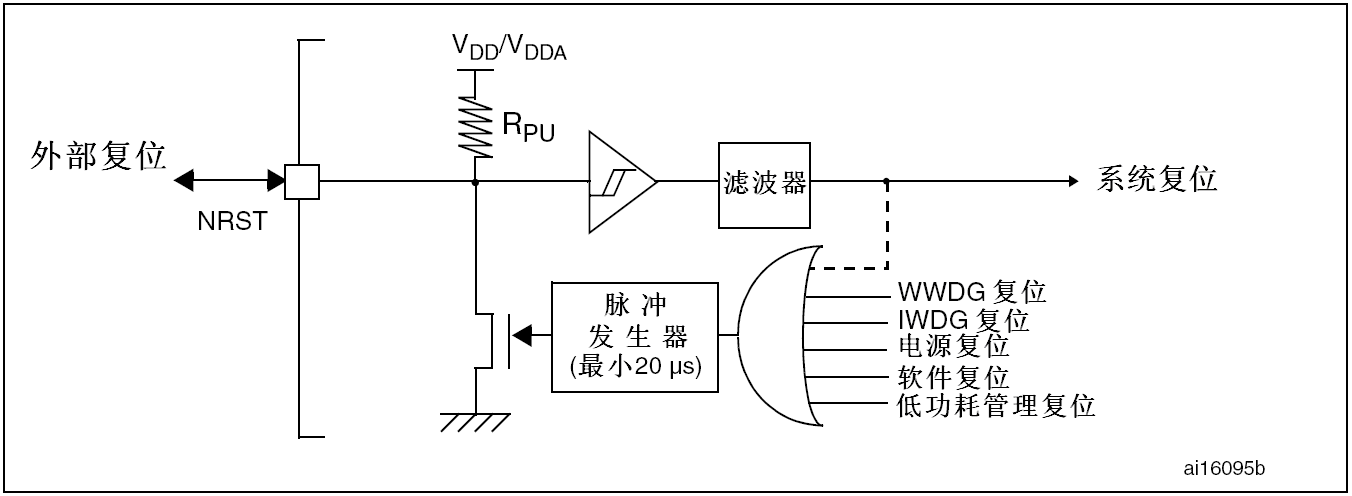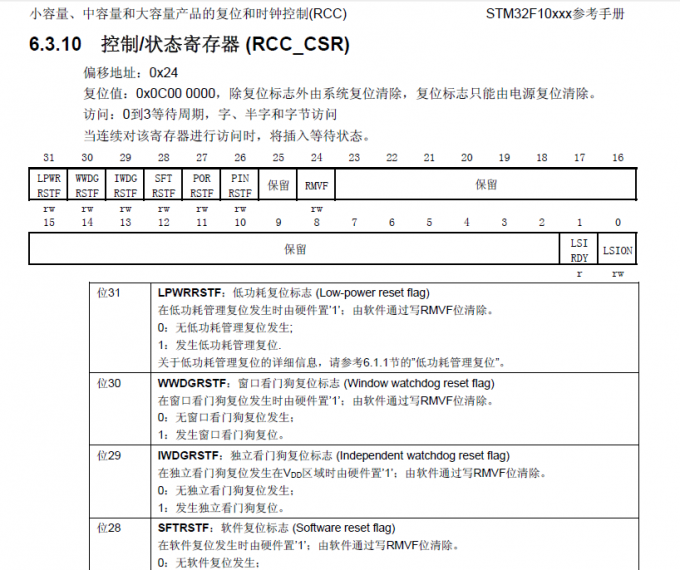摘要
STM32F10xxx支持三种复位形式,分别为系统复位、上电复位和备份区域复位。本文将通过实际的代码来解释各种情况下,软、硬件导致芯片复位的判别和怎样采取措施。
一、系统复位
系统复位将复位所有寄存器至它们的复位状态。 当发生以下任一事件时,产生一个系统复位:
- NRST引脚上的低电平(外部复位) 2. 窗口看门狗计数终止(WWDG复位)
- 独立看门狗计数终止(IWDG复位)
- 软件复位(SW复位)
- 低功耗管理复位 可通过查看RCC_CSR控制状态寄存器中的复位状态标志位识别复位事件来源。
软件复位通过将Cortex™-M3中断应用和复位控制寄存器中的SYSRESETREQ位置’1’,可实现软件复位。请参考Cortex™-M3技术参考手册获得进一步信息。
- 低功耗管理复位 可通过查看RCC_CSR控制状态寄存器中的复位状态标志位识别复位事件来源。
1.1 低功耗管理复位在以下两种情况下可产生低功耗管理复位:
- 在进入待机模式时产生低功耗管理复位: 通过将用户选择字节中的nRST_STDBY位置’1’将使能该复位。这时,即使执行了进入待机模式的过程,系统将被复位而不是进入待机模式。
- 在进入停止模式时产生低功耗管理复位: 通过将用户选择字节中的nRST_STOP位置’1’将使能该复位。这时,即使执行了进入停机模式的过程,系统将被复位而不是进入停机模式。
关于用户选择字节的进一步信息,请参考STM32F10xxx闪存编程手册。
- 在进入停止模式时产生低功耗管理复位: 通过将用户选择字节中的nRST_STOP位置’1’将使能该复位。这时,即使执行了进入停机模式的过程,系统将被复位而不是进入停机模式。
电源复位
电源复位当以下事件中之一发生时,产生电源复位:
- 上电/掉电复位(POR/PDR复位)
- 从待机模式中返回 图4) 电源复位将复位除了备份区域外的所有寄存器。
(见图中复位源将最终作用于RESET引脚,并在复位过程中保持低电平。复位入口矢量被固定在地址0x0000_0004。
- 从待机模式中返回 图4) 电源复位将复位除了备份区域外的所有寄存器。
芯片内部的复位信号会在NRST引脚上输出,脉冲发生器保证每一个(外部或内部)复位源都能有至少20μs的脉冲延时;当NRST引脚被拉低产生外部复位时,它将产生复位脉冲。

三、备份域复位
备份区域拥有两个专门的复位,它们只影响备份区域(见图4)。 当以下事件中之一发生时,产生备份区域复位。
- 软件复位,备份区域复位可由设置备份域控制寄存器 (RCC_BDCR)(见6.3.9节)中的BDRST位产生。
- 在VDD和VBAT两者掉电的前提下,VDD或VBAT上电将引发备份区域复位。
四、复位的标志位
五、复位标志位检索/判断什么原因导致的复位
标志位判断的代码由官方库中给定代码如下:
FlagStatus RCC_GetFlagStatus(uint8_t RCC_FLAG);//FlagStatus 分为SET和RESET两种;
1 |
|
当然判断完后,我们需要将复位类型的标志置位以防后期出现重复多次判断
void RCC_ClearFlag(void);//清除复位执行函数
代码原型如下:
1 | /** |
- 在使用时,只需要执行如下语句即可:
1 | if(RCC_GetFlagStatus(RCC_FLAG_PORRST) != RESET) |
六、STM32软件复位方法
在Cortex-M3权威指南中有这么一句话这里有一个要注意的问题:从SYSRESETREQ 被置为有效,到复位发生器执行复位命令,往往会有一个延时。在此延时期间,处理器仍然可以响应中断请求。但我们的本意往往是要让此次执行到此为止,不要再做任何其它事情了。所以,最好在发出复位请求前,先把FAULTMASK 置位。所以最好在将FAULTMASK 置位才万无一失。
1 | void mcuRestart(void) |

